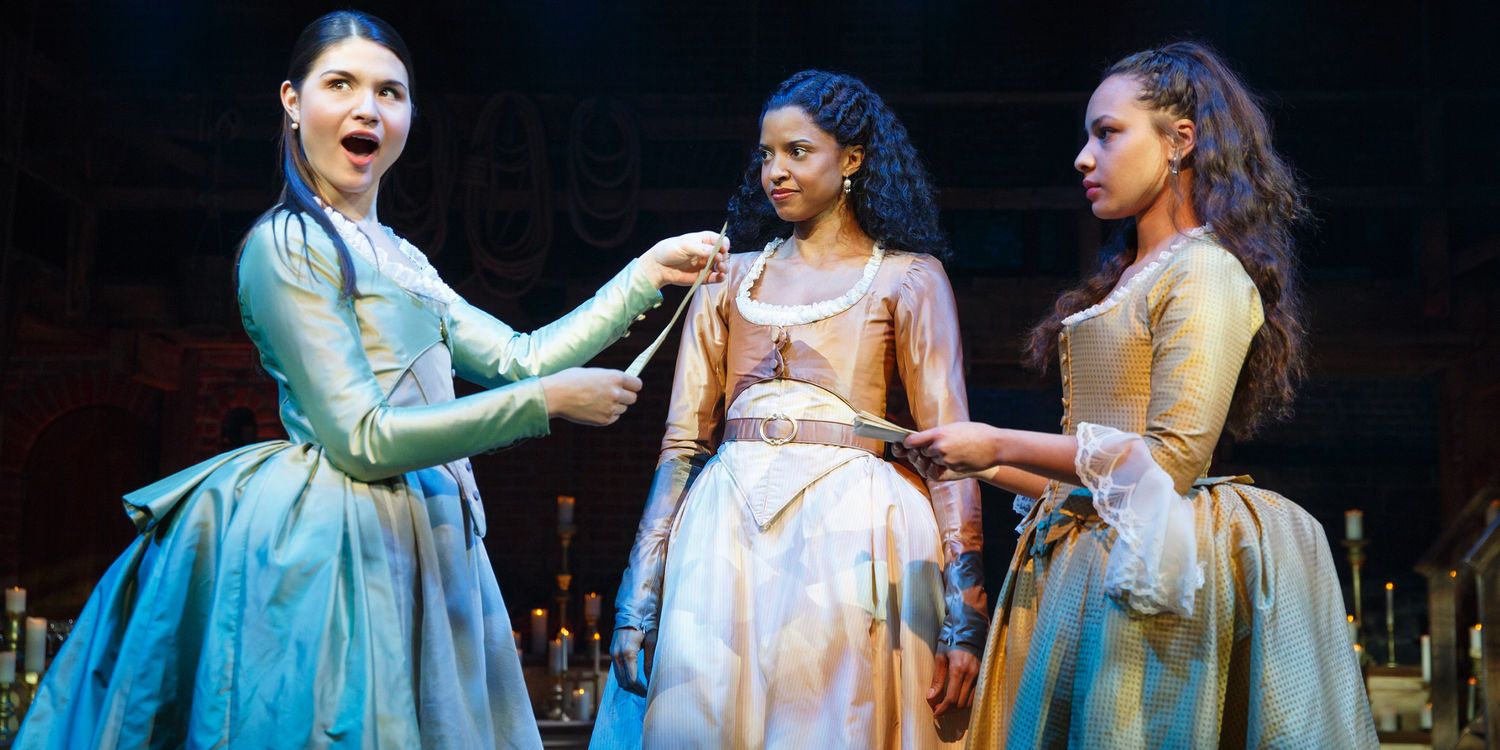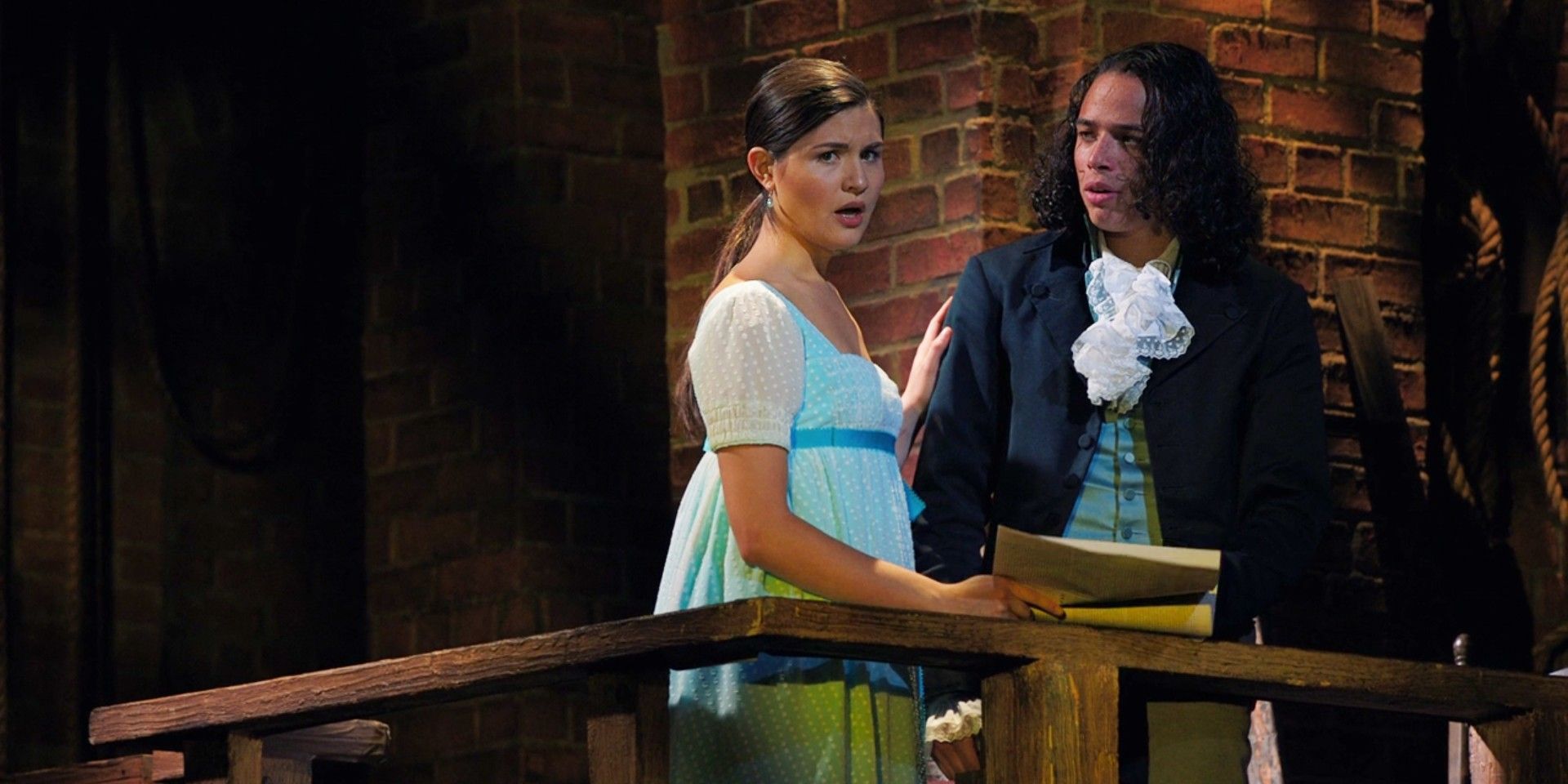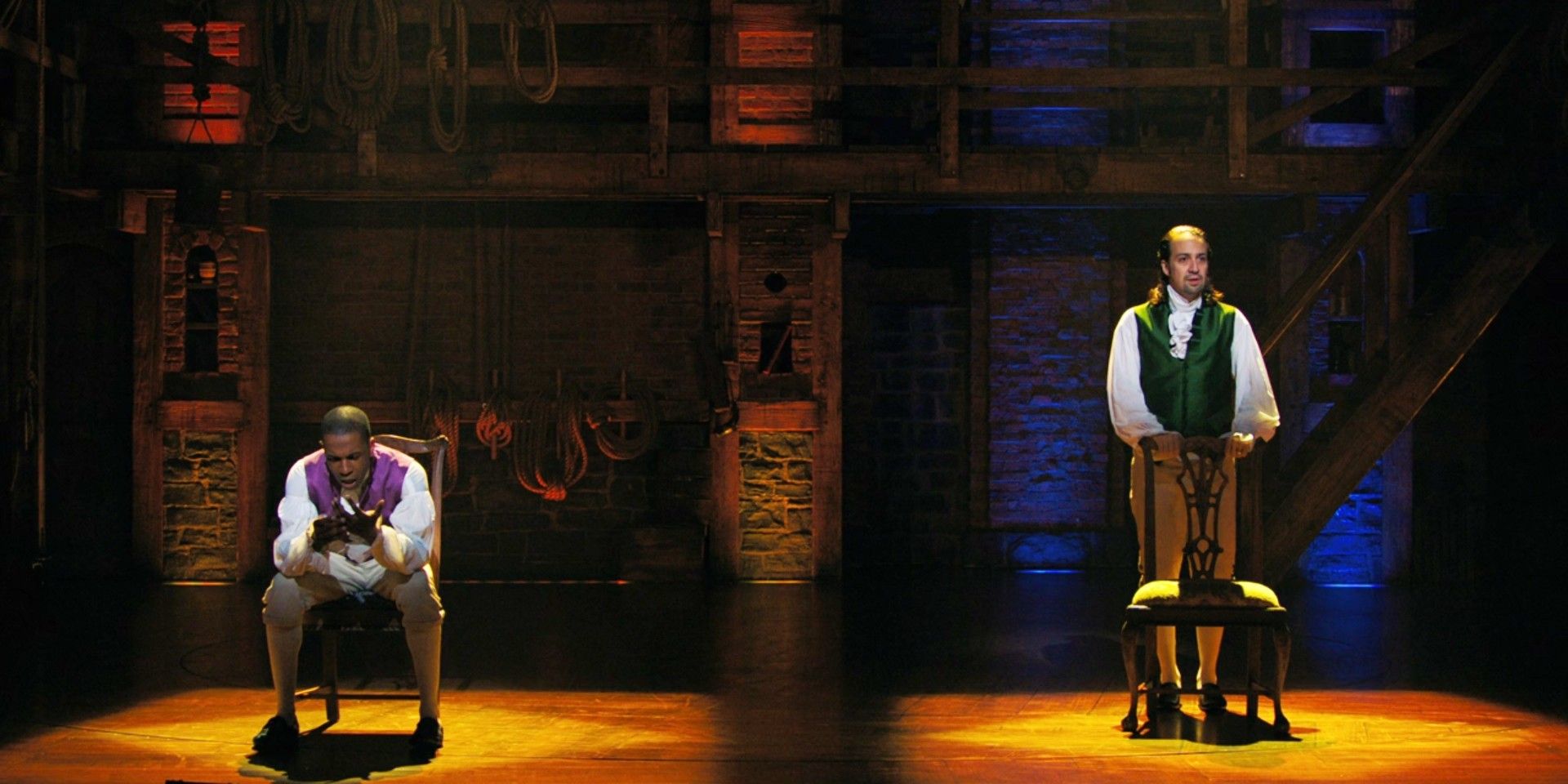
The production of Hamilton that made its way to Disney+ is full of hummable melodies and intricate lyrics, but what about the songs that were cut before the actors got to perform them on the Broadway stage? Hamilton's composer Lin-Manuel Miranda has talked at length about the arduous process of writing the biographical musical about America's first treasury secretary. "My Shot," Alexander Hamilton's first solo number in the show, took a whole year to write, so it must have been painful for Miranda to cut any songs from the show.
Editing material is obviously crucial when creating art of any kind and, in theatre, creators have the ability to try out many songs for its audiences before locking in their final product. Some of Hamilton's cut songs, therefore, debuted during preview performances at The Public Theatre prior to its Broadway opening and were removed due to poor audience reaction. Others were trimmed or omitted for timing purposes. Still others were deemed too confusing or too distracting from the main story.
Though they may not have made it into the final version of the show, there are many interesting things that can be revealed about the early creative process, the story fans could have been told, and the show which they ultimately got. Here are the 13 songs that were deleted from Hamilton.

Phillipa Soo's vocal prowess is on full display in one of her signature songs, "Helpless" but that song was a late addition to the musical. Originally, a song entitled "This One's Mine" was sung during Alexander Hamilton and Eliza Schuyler's wedding, but Lin-Manuel Miranda's own wife intervened, saying the original tune could not be characterized as a "love song." Taking her words to heart, Miranda wrote one of Hamilton's most compelling entries, setting up the show's one-two punch that is the "Helpless"/"Satisfied" time-bending sequence.

An early version of what would eventually morph into the song "Stay Alive," "Valley Forge" more explicitly describes the conditions for Washington's men, as Hamilton sees "the best minds of [his] generation waste away in pestilence and starvation." The original song made its way to the Hamilton Mixtape, a collaborative album released in 2016 featuring surviving and cut songs from the show, and is performed with a much more defeated, melancholy energy. In the demo track, unlike the song's final draft, there is no reference to the events surrounding General Charles Lee, nor does it serve as a prelude to his proceeding duel with John Laurens.
Since the number would have presumably followed other heart-wrenching songs ("Satisfied" and "Wait For It"), it appears that Miranda and his collaborator, music director Alex Lacamoire, opted for a less dramatic, sad tone and instead embraced the more rhythmic and energetic "Stay Alive."

Of all of Hamilton's Act I characters, it is perhaps Hercules Mulligan who gets the least amount of narrative closure. Surely aiming to rectify this, a short rap was added for the character midway through the act, showing the former tailor apprentice's apparent departure from the war. Despite Mulligan's historical importance to Hamilton's story, the creative team's choice to omit the rap was in an attempt to streamline the story and save his big moment for his rap in "Yorktown (The World Turned Upside Down)."

Another song that made its way onto the Hamilton Mixtape album, "No John Trumbull" was also performed during the show's initial run at the Public Theatre. The number, which was sung early in Act II and preceded "Cabinet Battle #1," showed Aaron Burr looking at one of Trumbull's paintings of the Founding Fathers, musing at how despite their "humble" expressions do not capture the messiness of their political maneuverings. The moment is one of many in which Aaron Burr, the show's narrator, breaks the fourth wall and speaks directly to the audience. It also foreshadows the disastrous and polarizing events of the next scene's cabinet meeting. The song, while short, was most likely cut due to its breaking up of the flow from the action. In addition, perhaps artist John Trumbull was deemed too much of a deep-cut for modern audiences.

No, Frozen's Elsa did not make an appearance in the show's earlier iterations. During Hamilton's off-Broadway run, the original "Schuyler Defeated" gave more political context regarding Burr's victory over the Schuyler patriarch." Eliding directly into the unused song "Let it Go," an angered Alexander approaches his rival but is intercepted by his son and wife Eliza, who urges him to, well, "let it go." Washington joins in, sharing her sentiment, and they duet.
The numbers were removed almost entirely, but the small confrontation between Burr and Hamilton remains and still conveys the growing tension between the two men in what remains of "Schuyler Defeated." Burr's political strategy ("Shake hands with him! Charm her!") was eventually lifted from "Let It Go" and included in what became "The Election of 1800." Hamilton creators took the historical information and important beats from the original songs, distilled them down, and re-distributed snip-its to more narratively appropriate places.

While the first two cabinet battles remain in the final draft, "Cabinet Battle #3" just didn't make the cut, and for reasons which are understandably complex and difficult to articulate. Displaying his anti-slavery leanings, Hamilton attacks Jefferson, Madison, and - by extension - Washington for their ownership of slaves and demanding that they legislate for their "unanimous emancipation."
While the musical makes many references to his status as an abolitionist, Hamilton's own relationship to slavery is far murkier. While he did not necessarily own slaves, he did purchase several on behalf of his father-in-law and was a vocal proponent of the 3/5 Compromise, dehumanizing legislation which recognized enslaved Black people as 3/5 of a person, ensuring "fair voting power" for the southern states. While it is true that on the whole Hamilton was a far more progressive thinker and more critical of slavery than his colleagues, he often kept these feelings private and there is no record of a confrontation between Treasury Secretary and Washington regarding this matter. This cut may have been to keep the events surrounding Hamilton's life more historically accurate, but also has the consequence of sweeping unfortunate truths under the rug.

While much of "One Last Ride" is preserved in the Washington-led "One Last Time," it's greatly changed from the original version. Initially, the song referred to Washington and Hamilton teaming up and taking charge during the Whiskey Rebellion, a tax protest taking place primarily in Western Pennsylvania in the early 1790s. The song, as sang in a demo by Miranda, is far bouncier, funnier, and features a drunk duo going out in a blaze of glory. Hamilton's joke-laden song ultimately evolved in favor of a mellower send-off for the nation's first president. Likewise, intended to be performed for Washington's death the reprise was also deleted. Since the song would have appeared shortly before Hamilton's own duel with Aaron Burr, it was likely removed to remain focused on Hamilton's journey.

While the song "The Adams Administration" survived into the Broadway run and onto Disney+, a major part was excised after the Public Theatre performances. Originally, Hamilton rapped his tirade against the nation's second Commander-In-Chief, chiding his "malevolence" and claiming that he'll "die of irrelevance." The rap was ultimately replaced with the more succinct "Sit Down John" callback to the musical 1776.
Since John Adams never physically appears in the show, it makes sense to remove the lengthy rap which is hurled at him. The omission ultimately allows for more time dedicated to other characters and the events of the play's final minutes. And, of course, Miranda is well-known for his homages to musical theatre classics!

Originally, Hamilton would have gone to George Washington and asked him for guidance after admitting his affair with Maria Reynolds to Burr, Jefferson, and Madison. The song, an early draft, came before the choice was made to give Washington his previously mentioned grand exit in "One Last Time," so it is likely that the creators were reluctant to bring him back for what is ultimately unnecessary to the plot. The choice to go straight into "Hurricane" makes the impact on Hamilton apparent without the need to discuss his feelings with Washington.

While it would have been wonderful for Angelica to have more solos in the musical, her Act II number "Congratulations" was likely cut to keep the story focused. Coming right after the release of the Reynolds Pamphlet, Angelica admonishes Hamilton for his actions and pledges loyalty to her wronged sister. However, the song ultimately undercut Eliza's own reaction - on display so beautifully in the next song, "Burn" - and, with its absence, left room for her to grieve.

Reprising the number from the end of Act I, this song is a beautiful number sung by Burr after the death of his wife Theodosia, and was present at The Public Theatre's version of the show. However, since both Burr's wife and daughter share the name, it is thought that the creators worried about confusing their audience.

While many sections of the song's original version remain intact in the musical's final form, initially "Your Obedient Servant" utilized many words and phrases from the real-life correspondence between Hamilton and Burr. While the letters and their contents were extensive and full of more confrontational language (replicated in the song's original version), Miranda eventually opted for a lighter, more comical approach.

Eventually replaced with "The World Was Wide Enough," "Ten Things, One Thing" was given a major re-write between the show's off-Broadway and Broadway runs. The first draft, which also takes place during the legendary Hamilton-Burr duel, describes the ten-step countdown from Burr's perspective before rewinding and showing the same event from Hamilton's eyes. In his final draft, Miranda decides to stop time for the show's titular character as the bullet makes its way toward him. Hamilton is given space to consider his own mortality and, with Thomas Kail's brilliant staging, he witnesses moments from his life with a dream-like focus. The resulting scene is much more effective, compelling, and ultimately satisfying for such a well-built climax.
Regardless of the reasons for their removal from the final product, the cut songs of Hamilton are interesting documents which give insight into the show's long and complicated creation. Thankfully, with the release of the Hamilton Mixtape and other resources provided by Miranda and the creative team, fans everywhere have access not only to Alexander Hamilton's history, but to the history of the biographical mega-musical, as well.
from ScreenRant - Feed https://ift.tt/3aOTKFe



0 Comments